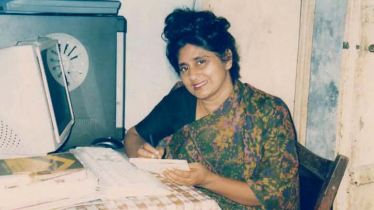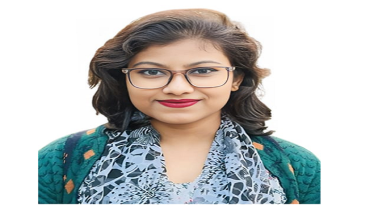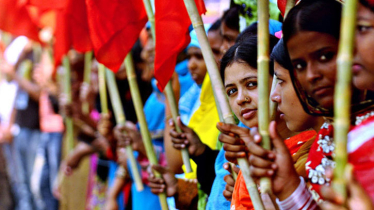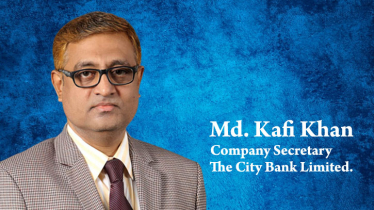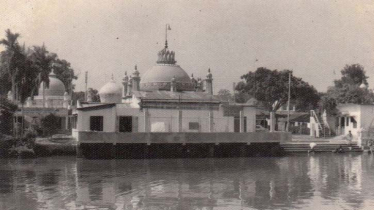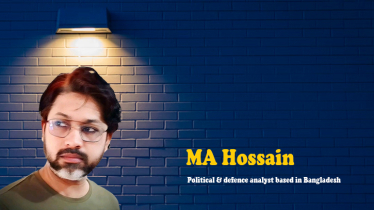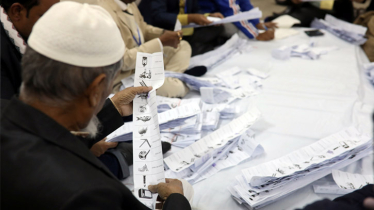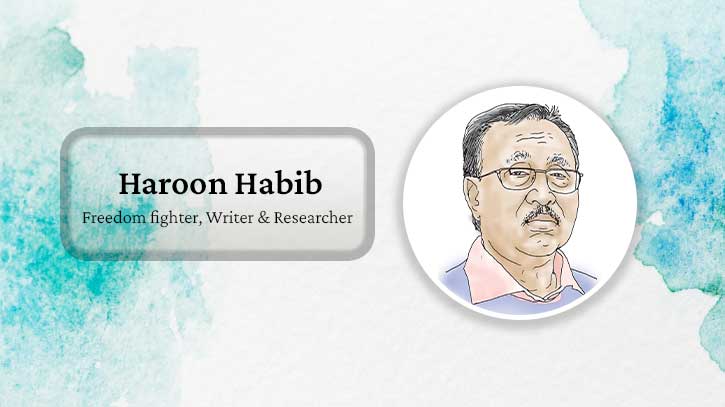
Recalling the days of 1971 is indeed a great pleasure. It is more rewarding for a person who took up arms as a member of the Mukti Bahini, and also worked as a young reporter to cover the battlefields as well as the lives of hundreds of thousands of refugees who had to take shelter in the Indian territories to escape brutalities of the Pakistan army. All these are the precious personal memories. However, the reminiscence is not out of pain either. The nine months of 1971 that we passed through, the degree of violations of human rights by the marauding Pakistan army and their local goons that we saw, the brutality in the name of religion that we witnessed, were all unspeakable.
So, we saw both sides of the coin: one is full of human tragedy caused by a genocidal army, and the other, the valour of the masses who were fiercely determined to protect their rights undoing the design of the vested quarters. History is packed with evidence that if a nation is awakened, it’s hard to suppress them by force. The year 1971 when Bangladesh was born, was no exception. Bengalis, traditionally known as a peace-loving and non-warring nation, stood up against a well-equipped army and finally succeeded. The cost was indeed heavy.
Like thousands of others of my age, as a final year student of Dhaka University’s Department of Journalism, I took part in the national war with a dream to unchain the Pakistani shackles deeply influenced by the gifted leadership of the nation’s founding father Bangabandhu Sheikh Mujibur Rahman. I was not a full professional at that time but an aspirant to be involved in the domain of journalism in the future. However, I maintained personal contact with a number of senior professionals whom I knew closely Faiz Ahmed, Toab Khan, MR Akhtar Mukul, Kamal Lohani, Santosh Gupta, Saleh Chowdhury and Salimullah were among those seniors who guided me from time to time. But the events of 1971 offered me an opportunity to serve the Swadhin Bangla Beter Kendro, and the Joy Bangla weekly, the two popular mouthpieces of the wartime government from the battlefields.
As I was appointed by the Mujibnagar government as War Correspondent for Sector 11, my space for work had expanded. Since then, I was blessed with three weapons– a Sten gun, a Camera and a Pen. These weapons had given me ample scope to know much beyond the waterfront I belonged, taking me to travel across many other war zones of greater Mymensingh, and parts of the regions under greater Rangpur.
The war the Bengalis fought in 1971 was not a traditional one between two established armies. On the one hand, the Pakistani military machine suppressed the rightful democratic shares of the Bengalis who constituted the majority population of the country while on the other, unarmed masses had to wage a people’s war to end the injustices and tortures that they had experienced during 23 years of united Pakistan.
As all would know, the flame of the armed struggle was ignited due to the outright denial of the outcome of Pakistan’s first-ever general elections held in 1970 in which the Awami League party under the stewardship of Bangabandhu Sheikh Mujibur Rahman won a landslide victory, but the military ruler Gen Yahya Khan, with support from Pakistan Peoples Party (PPP) led by Zulfiqar Ali Bhutto, refused to hand over power to the elected representatives. The armed confrontation began after the declaration of Bangladesh’s independence by Bangabandhu Sheikh Mujibur Rahman on March 26, 1971, followed by the full-scale genocide of the Pakistani army in Dhaka on the night of March 25, 1971. The abrupt military aggression that too was in the midst of a treacherous negotiation process put Dhaka in flame. Curfew was imposed. Tanks rolled. The army contingents moved from one area to another killing innocents and burning Dhaka at their will. High flames of fire engulfed the city.
The one-sided war silenced all newspapers of Dhaka and Chattogram while most journalists went into hiding for personal security. The scenario was violent, no one knew who is going to die. The Bengali nationalists, meanwhile, began resistance all over not in unison. Media, precisely the newspapers of Dhaka and Chattogram suspended their publications from March 26. The military rulers quickly imposed strict censorship so that no newspapers can give objective coverage of the brutal military actions.
This news blackout continued. The media outlets were put under the guns and boots of the occupation army. The military continued the brutalities till the end of the war, in mid-December, when the Pakistan Eastern Command surrendered unconditionally with their 93, 000 troops to the Joint Command of the Mukti Bahini (Freedom Fighters) and Mitra Bahini (Allied Force).
At least. five newspaper offices in Dhaka – Ittefaq, Sangbad, the People, Ganobangla and Nayabangla – were burned to ashes, a senior journalist-cum-writer Shaheed Saber was burned to death in his office. These newspapers faced the vengeance of the military because they supported the Bengali nationalist movement, and highlighted the misdeeds of the military junta quite often. The killer army and their local goons also butchered at least 17 leading journalists in Dhaka alone. The prominent journalists who were murdered in Dhaka in 1971 by the Pakistani army and their local goons, are - Sirajuddin Hussain, Shahidullah Kaiser, Shaheed Saber, Nizamuddin Ahmed, Syed Nazmul Huq, ANM Golam Mostafa, Khandakar Abu Taleb, Selina Parveen, Chisty Shah Helalur Rahman, Sib Sadhan Chakrabarty, Muhammaed Akhtar and SA Mannan.
Abidur Rahman, who edited a new English daily, The People, that had played a fearless role, defying the military government’s orders and recalling the horror of March 25 night: “The city was under curfew and we only heard and saw gunfire flaming around the city, never sure where it was. The sudden ‘Dead City’ eclipsed by the horror sounds with the threat of death looming left behind a mirror image of a graveyard – with it’s entire speechless population frozen in fear.”
The newspaper was among the first offices in Dhaka to face the military wrath. Recalling the days, the editor further recalled: “On March 27 morning, the curfew was lifted for four hours. One of the security guards of The People rushed to my place in tears letting me know that the office was under attack by a tank and that the army contingent had set it on fire. It was an irony of fate that the high flames of fire the whole city saw on the night of March 25 was the fire rising from my office.”
In the ruthless military crackdown, aimed at crushing the Bengali resurgence for freedom and justice, the military government of Gen Yahya Khan had also forced the closure of the highly popular weekly Swaraj — edited by Faiz Ahmed and Awaj— edited by Abdul Gaffar Chowdhury and Banglar Bani — edited by Sheikh Fazlul Haq Moni. Janata, a weekly, was also shut down. The military machine also launched successive attacks on newspaper offices including the weekly Purbadesh, Dainik Pakistan and Pakistan Observer as they were not happy with them for certain coverage.
Precisely, this was the state of the media from March 26, 1971 onward when many journalists either went into hiding or were on their runs to the Indian territories seeking safety. After a few days of the March 25 military crackdown, which is now the ‘National Genocide Day’ of Bangladesh, the military authorities forced most newspapers in Dhaka and Chattogram to reappear. But they could publish only what the military bosses permitted them to do.
Therefore, despite their glorious role in the pre-war phases, the local media outlets were under strong military chains; they failed to publish the news objectively, thanks to the stringent government control. Besides they had no choice but to entertain the woeful military propaganda, that the Mukti Bahini were the ‘miscreants, ’or the ‘Indian agents’ or the ‘enemies of Islam’! The military censorships were so outrageous that army officers sitting in the Inter-Service Public Relations (ISPR) office edited not only the news items but also news photographs, opinion pieces and editorials!
Remarkably, all these media outlets were seen playing the most independent role till March 25, 1971. They highlighted, quite objectively, the nationalist causes of the Bengalis and fearlessly opposed the unjust actions of the military rulers. They also supported the nationalist spirit of the population, whose cultural, political, and economic rights were grossly undermined during the Pakistani domain. While popular dailies like Ittefaq and Sangbad played a major role, Dainik Azad, the Pakistan Observer, and Dainik Pakistan, despite their limitations, were in favour of democratic rule.
It can be said from my own experiences that the nationalist movement in former East Pakistan, which took a shape of a total mass upsurge from a mere political campaign started in 1966 following the Six-Point Charter placed by Sheikh Mujibur Rahman, got wider acceptance among the populace as the mainstream newspapers had displayed heroic professionalism in projecting the reality.
However, all newspapers were neither objective nor patriotic, so to say. Some of them fiercely stood against the cause of justice and freedom. A number of dailies, mostly owned by the Muslim League leaders including the Dainik Paigam, patronised by the then Governor of East Pakistan, Abdul Monaem Khan, were overtly against the secular Bengali spirit. The Morning News run by the Press Trust of Pakistan supported the Pakistani cause. Dainik Sangram, run by the fundamentalist Jamaat-e-Islami party that took up arms to defend Pakistan, supported the military atrocities upon unarmed civilians with a political vengeance, turning itself as the main Pakistani mouthpiece against Bangladesh’s independence. While the PTV, which went on-air in 1964, was a controlled official organ.
The Bengali-speaking broadcaster of Radio Pakistan’s Dhaka station located in Shahbagh, showed their unique courage. Despite being cordoned off by the Pakistani troops with machine guns, they took the unprecedented move of shutting down the radio when the government ordered them not to air the 7th March Ramna Racecourse speech of Bangabandhu Sheikh Mujibur Rahman, in which he urged the people to resist the occupation army by all means. The heroic protest yielded results: the radio aired the 7th March speech the very next day.
Against the backdrop of brutal suppression of national media voices, some international media outlets came forward. Many global newspapers including the Sunday Times and Telegraph of London, played a significant role. To inform the world, about the genocide and mass rape in East Bengal, Anthony Mascarenhas, Simon Dring, Sydney H. Schanberg, Mark Tally and Dan Coggin were among the respected names in world journalism who contributed immensely.
Dan Coggin, the great American journalist who covered the Vietnam War, interviewed Bangabandhu Sheikh Mujibur Rahman just before the 25 March 1971 Pakistani military crackdown. Defying risks to his life, he covered the crucial events of 1971, painstakingly and extensively, which few other foreign journalists could do. The coverage, including several cover stories in TIME magazine, that Dan and his colleagues had done, will always be remembered as the most dependable eyewitness accounts of Bangladesh’s independence history. Arnold Zeitlin, the then Pakistan bureau chief of the Associated Press, was the first Western journalist who dispatched a brief censored report on the military’s crackdown in Dhaka on 25 March 1971.
Besides, The Observer, Guardian and the Telegraph of England; New York Times, Washington Post, Christian Science Monitor and the major weeklies like the Time and Newsweek of the United States and Far Eastern Economic Review of Honking had also published scores of major reports with pictorial support, not only highlighting the plights of the refugees and analysing the political developments, they also reported the growing firepower of the Mukti Bahini against the Pakistani troops. Soviet Union’s Pravda, most media outlets in the socialist bloc, Japanese newspaper Asahi Shimbun and some other media houses in Australia also played a significant role. The media in communist China, a staunch supporter of Pakistan in 1971, remained indifferent to genocide and the refugee crisis.
Indian state radio Akashvani’s Kolkata Centre, the British Broadcasting Corporation (BBC) and Australian radio’s role in giving positive coverage has to be reckoned with. Akashvani’s daily news bulletins were immensely popular. Devdulal Bandhapadhya and Pronobesh Sen became household names for the radio’s immensely popular Sangbad Parikkrama programme. The BBC became a household name among Bengali listeners in 1971 mainly due to its objective coverage.
The year 1971 also witnessed one of the biggest refugee crises in human history. Ten million people from Bangladesh had to cross the border to India, to escape the brutality of the genocidal army. They took shelter along the border areas of four Indian states – West Bengal, Tripura, Meghalaya, and Assam–, thanks to Prime Minister Indira Gandhi and the Indian people. The hospitals of the Indian north and Northeast were full of Bangladeshi refugees – mostly wounded by bullets and bayonets. Raped and tortured mercilessly, thousands of women managed to cross the border.
The Indian newspapers, which were all alone watching the Bangladesh developments more closely than any other foreign outlets, gave predominant coverage to these humanitarian issues. Their contributions will remain enshrined in Bangladesh’s independence history. The pages of Jugantar, Ananda Bazar Patrika, Basumati, Kalantar, Amrita Bazar Patrika and the Statesman of Kolkata were full of Bangladesh coverage throughout. The Times of India, Hindustan Times, Pioneer, Indian Express and the Herald of New Delhi, The Hindu of Madras (now Chennai), The Assam Tribune and the Illustrated Weekly of India edited by Khusbant Singh played significant roles in supporting the Bangladesh cause. The role of Indian news agencies like the Press Trust of India (PRI) and the United News of India (UNI) was laudable.
To name a section of the Indian journalists who risked their lives in covering the Bangladesh war will be an injustice to many others. However, I should name at least a few whom I knew personally during and after the war. They are– Amulla Ganguli, Oshesh Chakrabarti, Manas Ghosh, Manoj Mitra and Satyabrata Chakrabarty of the Statesman, Asim Debroy, Tushar Pandit, Barun Sengupta, Sukharanjan Dasgupta and Arun Chakrabarty of the Anandabazar Patrika, Anil Bhattachajee (sr. ) Sukharanjan Sengupta, Kalyan Basu, and Anil Bhattacharjee of Jugantar, Suvash Chakrabarty, Kirit Bhaumik of Times of India, Madhusudan Guha Roy and Manik Chowdhury of PTI, Upen Tarafder, Nirmal Sengupta, Dipesh Bhowmik, Dilip Sen Gupta and Sanat Mukharjee of Akashvani and K K Chadda of the UNI are among others.
I had the opportunity to visit many of the refugee camps in the hills of Meghalaya, Tripura and Assam, where millions of uprooted people had taken shelter. I was neither a professional photographer nor an experienced cameraman. But the events of 1971 had given me the opportunity to capture hundreds of wartime pictures, mostly from the war fronts. The two cameras I used came from Major Abu Taher (later Col. Taher, Bir Uttam) who led Sector 11 of the War, and the other from Dr Abdul Hye, a physician turned Freedom Fighter.
The tiny Indian state of Tripura, with a population of 1. 5 lakh, had to accommodate equal number of Bangladesh refugees. Every house, educational and religious institutions of the state were overcrowded with refugees. Tripura had no dearth of love for the uprooted people from East Bengal, and also for the Mukti Bahini who received safe sanctuaries in their hills. I must name one newspaper, Dainik Sambad, edited by a fiercely Bangladeshi-lover, Bhupen Datta Bhowmik. This daily of Tripura had virtually turned into a Bangladesh liberation war newspaper in 1971. Another devout Bangladesh lover, Anil Bhattacharjee, played an important role during the war as a journalist and also as an activist. While the Saptahik Samachar, edited by him, was a vocal mouthpiece for Bangladesh Cause, his house in the Melarmath turned one of the key centres for Bangladesh leaders, both political and military, in Agartala.The communist party-owned weekly DESHER KATHA also gave extensive coverage.
The year 1971 also saw a unique boom of smaller size newspapers coming out from the border areas as well as from various war zones. Their number, according to my own assessments, is nearly 70 — dailies, weeklies and fortnightlies. Their coverage – news reports, features, pictures and commentaries – boosted the morale of the people. Although most of these publications were irregular and produced in a hurry, they played an important role, particularly when the voices of the mainstream newspapers were strangulated.
These smaller newspapers which were the passionate outcome of the displaced Bengali journalists with support from the pro-independence politicians, who crossed the border into Indian townships, played a historic role in an unprecedented crisis.
Haroon Habib is a freedom fighter, writer and researcher.
END/TDM/EHM

